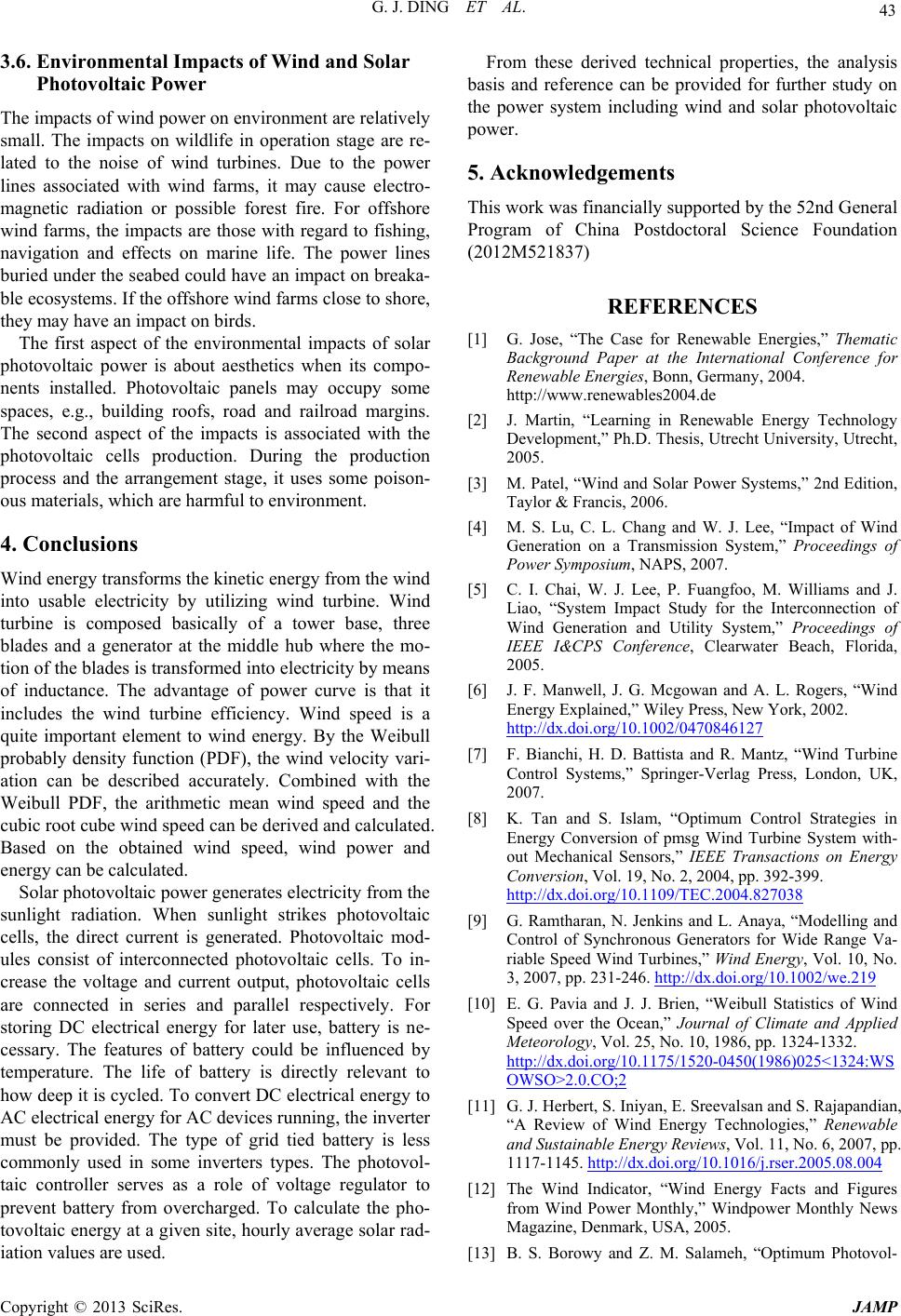
G. J. DING ET AL.
Copyright © 2013 SciRes. JAMP
3.6. Environmental Impacts of Wind and Solar
Photovoltaic Pow e r
The impacts of wind power on environment are relatively
small. The impacts on wildlife in operation stage are re-
lated to the noise of wind turbines. Due to the power
lines associated with wind farms, it may cause electro-
magnetic radiation or possible forest fire. For offshore
wind farms, the impacts are those with regard to fishing,
navigation and effects on marine life. The power lines
buried under the seabed could have an impact on breaka-
ble ecosystems. If the offshore wind farms close to shore,
they may have an impact on birds.
The first aspect of the environmental impacts of solar
photovoltaic power is about aesthetics when its compo-
nents installed. Photovoltaic panels may occupy some
spaces, e.g., building roofs, road and railroad margins.
The second aspect of the impacts is associated with the
photovoltaic cells production. During the production
process and the arrangement stage, it uses some poison-
ous materials, which are harmful to environment.
4. Conclusions
Wind energy transforms the kinetic energy from the wind
into usable electricity by utilizing wind turbine. Wind
turbine is composed basically of a tower base, three
blades and a generator at the middle hub where the mo-
tion of the blades is transfor med into electricity by means
of inductance. The advantage of power curve is that it
includes the wind turbine efficiency. Wind speed is a
quite important element to wind energy. By the Weibull
probably density function (PDF), the wind velocity vari-
ation can be described accurately. Combined with the
Weibull PDF, the arithmetic mean wind speed and the
cubic root cube wind speed can be derived and calculated.
Based on the obtained wind speed, wind power and
energy can be calculated.
Solar photovoltaic power generates electricity from the
sunlight radiation. When sunlight strikes photovoltaic
cells, the direct current is generated. Photovoltaic mod-
ules consist of interconnected photovoltaic cells. To in-
crease the voltage and current output, photovoltaic cells
are connected in series and parallel respectively. For
storing DC electrical energy for later use, battery is ne-
cessary. The features of battery could be influenced by
temperature. The life of battery is directly relevant to
how deep it is cycled. To convert DC electrical energy to
AC electrical energy for AC devices running, the inverter
must be provided. The type of grid tied battery is less
commonly used in some inverters types. The photovol-
taic controller serves as a role of voltage regulator to
prevent battery from overcharged. To calculate the pho-
tovoltaic energy at a given site, hourly average solar rad-
iation values are used.
From these derived technical properties, the analysis
basis and reference can be provided for further study on
the power system including wind and solar photovoltaic
power.
5. Acknowledgements
This work was fin ancially sup ported by the 52nd General
Program of China Postdoctoral Science Foundation
(2012M521837)
REFERENCES
[1] G. Jose, “The Case for Renewable Energies,” Thematic
Background Paper at the International Conference for
Renewable Energies, Bonn, Germany, 2004.
http://www.renewables2004.de
[2] J. Martin, “Learning in Renewable Energy Technology
Development,” Ph.D. Thesis, Utrecht University, Utrecht,
2005.
[3] M. Patel, “Wind and Solar Power Systems,” 2nd Edition,
Taylor & Fr ancis, 2006.
[4] M. S. Lu, C. L. Chang and W. J. Le e, “Impact of Wind
Generation on a Transmission System,” Proceedings of
Power Symposium, NAPS, 2007.
[5] C. I. Chai, W. J. Lee, P. Fuangfoo, M. Williams and J.
Liao, “System Impact Study for the Interconnection of
Wind Generation and Utility System,” Proceedings of
IEEE I&CPS Conference, Clearwater Beach, Florida,
2005.
[6] J. F. Manwell, J. G. Mcgowan and A. L. Rogers, “Wind
Energy Explained,” Wiley Press, New York, 2002.
http://dx.doi.org/10.1002/0470846127
[7] F. Bianchi, H. D. Battista and R. Mantz, “Wind Turbine
Control Systems,” Springer-Verlag Press, London, UK,
2007.
[8] K. Tan and S. Islam, “Optimum Control Strategies in
Energy Conversion of pmsg Wind Turbine System with-
out Mechanical Sensors,” IEEE Transactions on Energy
Conversion, Vol. 19, No. 2, 2004, pp. 392-399.
http://dx.doi.org/10.1109/TEC.2004.827038
[9] G. Ramtharan, N. Jenkins and L. Anaya, “Modelling and
Control of Synchronous Generators for Wide Range Va-
riable Speed Wind Turbines,” Wind Energy, Vol. 10, No.
3, 2007, pp. 231-246. http://dx.doi.org/10.1002/we.219
[10] E. G. Pavia and J. J. Brien, “Weibull Statistics of Wind
Speed over the Ocean,” Journal of Climate and Applied
Meteorology, Vol. 25, No. 10, 1986, pp. 1324-1332.
http://dx.doi.org/10.1175/1520-0450(1986)025<1324:WS
OWSO>2.0.CO;2
[11] G. J. Herbert, S. Iniyan, E. Sreevalsan and S. Rajapandian,
“A Review of Wind Energy Technologies,” Renewable
and Sustainable Energy Reviews, Vol. 11, No. 6, 2007, pp.
1117-1145. http://dx.doi.org/10.1016/j.rser.2005.08.004
[12] The Wind Indicator, “Wind Energy Facts and Figures
from Wind Power Monthly,” Windpower Monthly News
Magazine, Denmark, USA, 2005.
[13] B. S. Borowy and Z. M. Salameh, “Optimum Photovol-